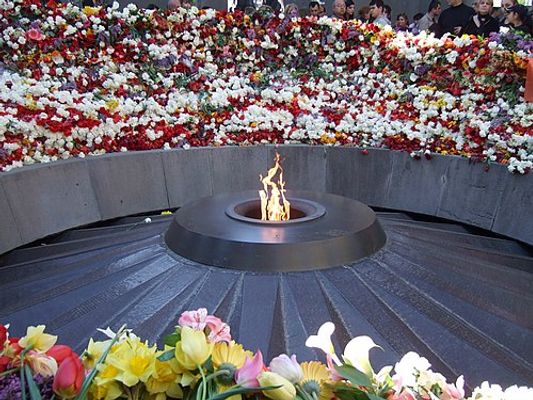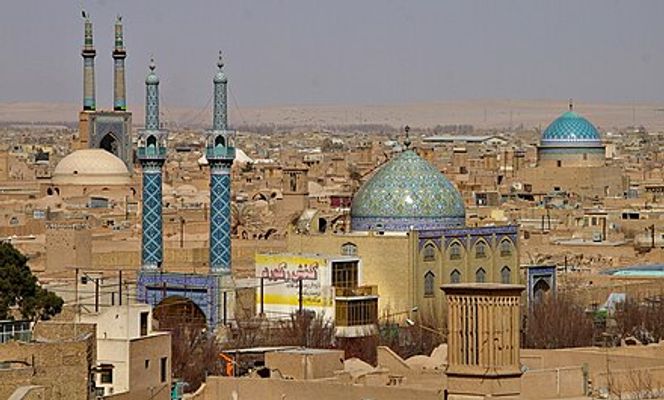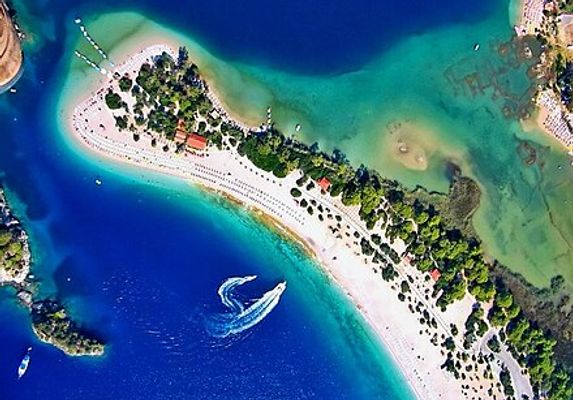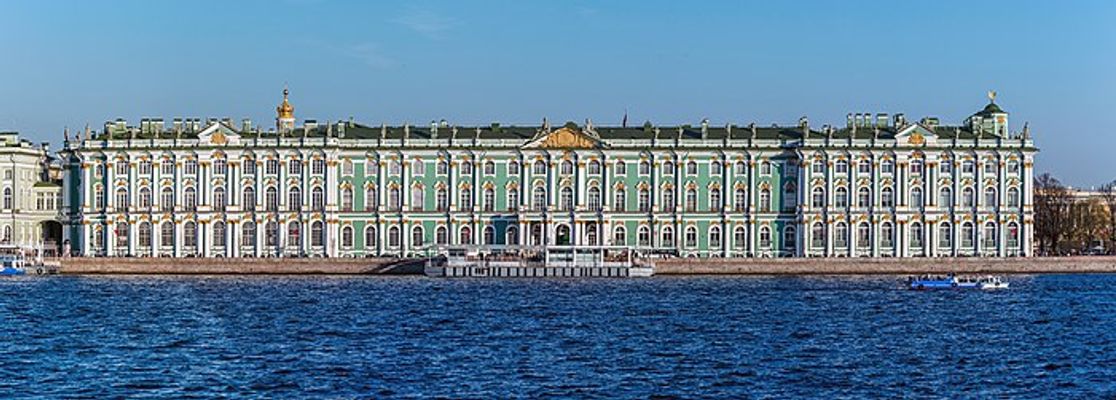
From Wikipedia: Azerbaijan (Azerbaijani: Azərbaycan) is a former Soviet republic in the Caucasus and variously considered part of Europe or Asia. The country lies on the Caspian Sea between Russia and Iran and is bordered to the west by Georgia and Armenia. The autonomous exclave of Nakhchivan lies between Armenia and Iran with a short border with Turkey. It is nicknamed the Land of Fire.
find another country
Quba

[from en.wikipedia.org]: Quba is a city and the administrative centre of the Quba District of Azerbaijan. The city lies on the north-eastern slopes of Shahdag mountain, at an altitude of 600 metres above sea level, on the right bank of the Kudyal river. It has a population of 47,200 (2023).

Shaki, Azerbaijan

[from en.wikipedia.org]: Shaki is a city in northwestern Azerbaijan, surrounded by the district of the same name. It is located in the southern part of the Greater Caucasus mountain range, 240 km (150 mi) from Baku. As of 2020, it has a population of 68,400. The center of the city and the Palace of Shaki Khans were inscribed in the UNESCO World Heritage List in 2019 because of their unique architecture and history as an important trading center along the Silk Road.

Khanegah tomb

[from en.wikipedia.org]: Khanegah on the Alinja River – is a tomb dated to between the 13th and 15th centuries and is located in the Khanegah village of Julfa District, Azerbaijan. The tomb is on the Alinja River.

Baku
Average temperatures
Jan
6.6°C2.1Precipitation: 21 mm
Feb
6.3°C2Precipitation: 20 mm
Mar
9.8°C4.2Precipitation: 21 mm
Apr
16.4°C9.4Precipitation: 18 mm
May
22.1°C14.9Precipitation: 18 mm
Jun
27.3°C19.7Precipitation: 8 mm
Jul
30.6°C22.2Precipitation: 2 mm
Aug
29.7°C22.9Precipitation: 6 mm
Sep
25.6°C19.4Precipitation: 15 mm
Oct
19.6°C13.6Precipitation: 25 mm
Nov
13.5°C8.8Precipitation: 30 mm
Dec
9.7°C4.8Precipitation: 26 mm

Ganja
Average temperatures
Jan
7°C0.5Precipitation: 8 mm
Feb
8.2°C1Precipitation: 12 mm
Mar
12.7°C4.3Precipitation: 24 mm
Apr
18.7°C9.4Precipitation: 31 mm
May
23.4°C13.8Precipitation: 40 mm
Jun
28.7°C18.6Precipitation: 32 mm
Jul
31.6°C21.4Precipitation: 17 mm
Aug
31.1°C21Precipitation: 15 mm
Sep
26.3°C16.8Precipitation: 15 mm
Oct
19.5°C11.6Precipitation: 24 mm
Nov
12.9°C6.2Precipitation: 16 mm
Dec
8.4°C2.1Precipitation: 7 mm

Lankaran
Average temperatures
Jan
7.2°C0Precipitation: 91 mm
Feb
7.2°C1Precipitation: 114 mm
Mar
11°C3.9Precipitation: 90 mm
Apr
17.5°C8.6Precipitation: 50 mm
May
22.5°C13.1Precipitation: 54 mm
Jun
27.2°C17.5Precipitation: 22 mm
Jul
30.4°C20.1Precipitation: 17 mm
Aug
29.5°C19.7Precipitation: 50 mm
Sep
25.9°C16.9Precipitation: 143 mm
Oct
19.9°C11.8Precipitation: 259 mm
Nov
14.1°C6.7Precipitation: 168 mm
Dec
10.1°C2.5Precipitation: 88 mm

Qabala
Average temperatures
Jan
4.4°C-3.9Precipitation: 43 mm
Feb
5°C-2.8Precipitation: 50 mm
Mar
9.4°C1Precipitation: 72 mm
Apr
17.3°C6.7Precipitation: 73 mm
May
21.1°C11.2Precipitation: 101 mm
Jun
26°C15.4Precipitation: 97 mm
Jul
29.5°C18.2Precipitation: 53 mm
Aug
28.6°C17.4Precipitation: 55 mm
Sep
24.8°C13.9Precipitation: 51 mm
Oct
17.4°C8.5Precipitation: 102 mm
Nov
11.4°C3Precipitation: 57 mm
Dec
7°C-1.4Precipitation: 41 mm

Sheki
Average temperatures
Jan
3°C-7Precipitation: 49 mm
Feb
9°C-6Precipitation: 46 mm
Mar
15°C-3Precipitation: 66 mm
Apr
18°C-3Precipitation: 75 mm
May
23°C6Precipitation: 105 mm
Jun
27°C17Precipitation: 77 mm
Jul
32°C18Precipitation: 69 mm
Aug
32°C16Precipitation: 20 mm
Sep
30°C15Precipitation: 80 mm
Oct
20°C9Precipitation: 80 mm
Nov
13°C2Precipitation: 44 mm
Dec
6°C-4Precipitation: 40 mm

Qobustan
Average temperatures
Jan
6°C0Precipitation: 47 mm
Feb
7°C2Precipitation: 44 mm
Mar
11°C4Precipitation: 38 mm
Apr
16°C9Precipitation: 27 mm
May
26°C15Precipitation: 34 mm
Jun
34°C22Precipitation: 20 mm
Jul
33°C23Precipitation: 13 mm
Aug
38°C24Precipitation: 5 mm
Sep
29°C21Precipitation: 53 mm
Oct
19°C12Precipitation: 52 mm
Nov
13°C8Precipitation: 73 mm
Dec
8°C4Precipitation: 46 mm

Göygöl National Park
Average temperatures
Jan
-8°C-14Precipitation: 32 mm
Feb
-6°C-13Precipitation: 35 mm
Mar
0°C-10Precipitation: 51 mm
Apr
8°C-6Precipitation: 63 mm
May
15°C-1Precipitation: 101 mm
Jun
19°C4Precipitation: 84 mm
Jul
17°C10Precipitation: 50 mm
Aug
23°C8Precipitation: 19 mm
Sep
18°C6Precipitation: 58 mm
Oct
12°C0Precipitation: 53 mm
Nov
3°C-6Precipitation: 48 mm
Dec
-4°C-10Precipitation: 39 mm

Khinalug
Average temperatures
Jan
-8°C-14Precipitation: 67 mm
Feb
-3°C-13Precipitation: 69 mm
Mar
3°C-9Precipitation: 64 mm
Apr
10°C-8Precipitation: 75 mm
May
15°C-3Precipitation: 70 mm
Jun
23°C4Precipitation: 49 mm
Jul
24°C8Precipitation: 42 mm
Aug
25°C8Precipitation: 17 mm
Sep
23°C5Precipitation: 88 mm
Oct
14°C-1Precipitation: 70 mm
Nov
4°C-7Precipitation: 71 mm
Dec
-2°C-12Precipitation: 81 mm

Quba
Average temperatures
Jan
2°C-4Precipitation: 62 mm
Feb
9°C-3Precipitation: 58 mm
Mar
15°C-1Precipitation: 55 mm
Apr
20°C2Precipitation: 53 mm
May
22°C11Precipitation: 44 mm
Jun
28°C15Precipitation: 33 mm
Jul
31°C17Precipitation: 27 mm
Aug
32°C19Precipitation: 11 mm
Sep
26°C13Precipitation: 66 mm
Oct
21°C8Precipitation: 47 mm
Nov
12°C2Precipitation: 55 mm
Dec
5°C-3Precipitation: 54 mm

Lahich
Average temperatures
Jan
1°C-6Precipitation: 60 mm
Feb
7°C-5Precipitation: 72 mm
Mar
13°C-1Precipitation: 57 mm
Apr
17°C2Precipitation: 50 mm
May
20°C7Precipitation: 72 mm
Jun
24°C14Precipitation: 47 mm
Jul
29°C16Precipitation: 36 mm
Aug
29°C18Precipitation: 7 mm
Sep
25°C13Precipitation: 59 mm
Oct
17°C8Precipitation: 52 mm
Nov
12°C2Precipitation: 54 mm
Dec
6°C-2Precipitation: 50 mm

Qax
Average temperatures
Jan
3°C-6Precipitation: 47 mm
Feb
9°C-5Precipitation: 43 mm
Mar
15°C-5Precipitation: 59 mm
Apr
18°C-7Precipitation: 65 mm
May
22°C2Precipitation: 88 mm
Jun
29°C15Precipitation: 78 mm
Jul
31°C20Precipitation: 69 mm
Aug
31°C17Precipitation: 23 mm
Sep
28°C15Precipitation: 83 mm
Oct
20°C9Precipitation: 78 mm
Nov
13°C-2Precipitation: 47 mm
Dec
7°C-5Precipitation: 40 mm

Shamakhi
Average temperatures
Jan
3.7°C-3Precipitation: 42 mm
Feb
4.1°C-2.5Precipitation: 45 mm
Mar
8.2°C0.8Precipitation: 73 mm
Apr
16.4°C6.7Precipitation: 69 mm
May
21.2°C11.2Precipitation: 74 mm
Jun
25.8°C15.4Precipitation: 54 mm
Jul
29.8°C18.4Precipitation: 21 mm
Aug
28.8°C17.6Precipitation: 19 mm
Sep
24.2°C13.7Precipitation: 36 mm
Oct
16.7°C8.1Precipitation: 73 mm
Nov
10.7°C3.9Precipitation: 49 mm
Dec
6.4°C-0.8Precipitation: 40 mm

Sumqayit
No climate information available.

Sheki Region
No climate information available.

Nabran
No climate information available.

Göygöl
No climate information available.

Naftalan
No climate information available.

Baku Region
No climate information available.

Nij, Azerbaijan
No climate information available.

Shamkir (city)
No climate information available.










